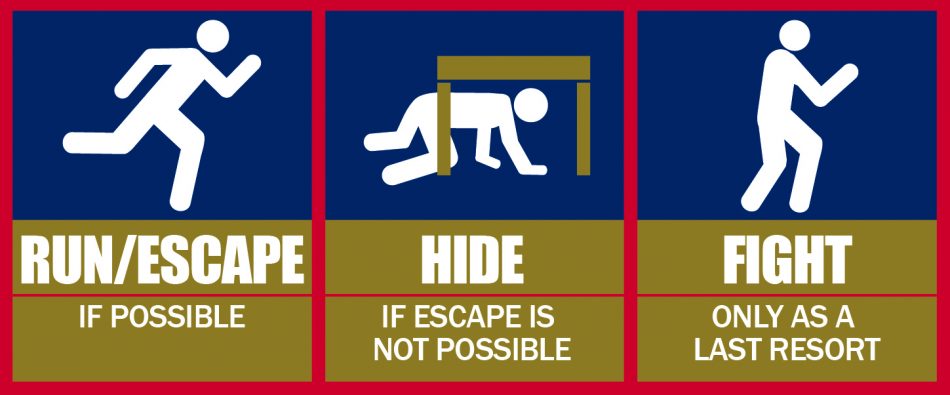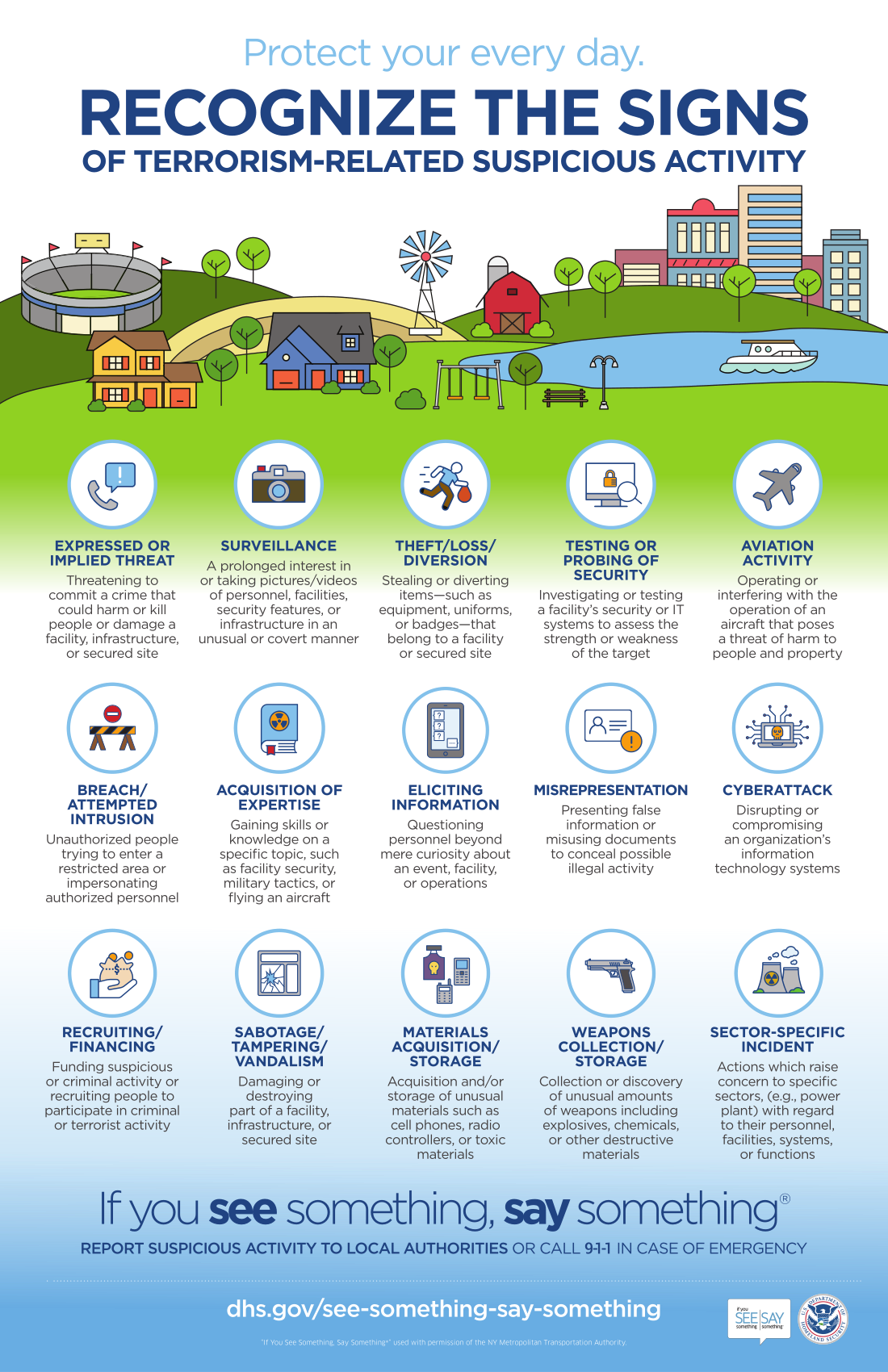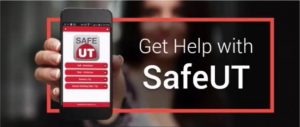Acts of Violence
THE POINT
Acts of violence include anything from terrorism and active shooter incidents to bullying and suicided. Be Informed about the protective actions.
DO THIS
Learn and teach others what to do in the event of any act of violence:
- Protective action against an immediate threat: RUN, HIDE, FIGHT
- Once it's safe to do so: Contact an authority
- If safe to do so, You Are The Help Until Help Arrives.
VIDEOS
DOWNLOADS
LINKS
- Hometown Security - CISA
- SafeUT App
- Suicide Prevention Resource Center
- LiveOnUtah.org
- Suicide Prevention Resources In Utah
- Ready.gov- Attacks in Crowded and Public Spaces
- You are the Help Until Help Arrives
- Active Shooter Preparedness Resources - FBI
- StopBullying.gov - Get Help Now
- 10 Ways to Help Your Child Overcome Bullying
- Insider Threat Mitigation Resources, Training and Tools
Acts of Violence
There are many ways that someone may intentionally hurt another or themselves. What ever the way, you can learn how to respond appropriately to save your life or the lives of others and how to Be the Help Until Help Arrives.
Active Shooter
FBI Active Shooter Incidents Study 2000-2013
Workplace violence is on the rise. Having a plan could make a difference to save lives and avoid disruption of your critical operations. Almost every day we turn on the news and hear about some active shooter incident across the
country or around the world.
According to a study done by the FBI of the 160 active shooter incidents in the US between 200-2013 there is a upward trend of shooting incidents. From 200-2013 the most common place for an active shooter is in the businesses. 45.6 % Commerce/ Private Sector, 24.4% Education/Schools, 10% in Government, the remaining 20% in Open Space, Residences, Houses of Worship & Health Care.
Active Shooter Preparedness for the Workplace
Active shooter situations are unpredictable and evolve quickly. Do your employees know how to respond? Typically, the immediate deployment of law enforcement is required to stop the shooting and mitigate harm to victims. Because active shooter situations are often over within 10 to 15 minutes, before law enforcement arrives on the scene, individuals must be prepared both mentally and physically to deal with an active shooter situation.
Does your business have a plan and do you exercise it? Consult your local law enforcement agency when developing your active shooter plan. They will have key information that will assist you in building a strong plan that can save lives. Training videos and a tabletop exercise, including facilitator notes, are included here to assist Utah businesses in preparing for this growing threat.
- Active Shooter Tabletop Exercise
- Active Shooter Tabletop Exercise Facilitator Guide
- Active Shooter Preparedness Resources - FBI
Terrorism
Acts of terrorism include threats of terrorism; assassinations; kidnappings; hijackings; bomb scares and bombings; cyber attacks (computer-based); and the use of chemical, biological, nuclear and radiological weapons. For details see this FEMA article.
The following are general guidelines to protect yourself:
- Be aware of your surroundings.
- Move or leave if you feel uncomfortable or if something does not seem right.
- Take precautions when traveling. Be aware of conspicuous or unusual behavior. Do not accept packages from strangers. Do not leave luggage unattended. You should promptly report unusual behavior, suspicious or unattended packages, and strange devices to the police or security personnel.
- Learn where emergency exits are located in buildings you frequent. Plan how to get out in the event of an emergency.
- Be prepared to do without services you normally depend on—electricity, telephone, natural gas, gasoline pumps, cash registers, ATMs, and Internet transactions.
Explosions
Parcels that should make you suspicious:
- Are unexpected or from someone unfamiliar to you.
- Have no return address, or have one that can’t be verified as legitimate.
- Are marked with restrictive endorsements such as “Personal,” “Confidential,” or “Do not X-ray.”
- Have protruding wires or aluminum foil, strange odors, or stains.
- Show a city or state in the postmark that doesn’t match the return address.
- Are of unusual weight given their size, or are lopsided or oddly shaped.
- Are marked with threatening language.
- Have inappropriate or unusual labeling.
- Have excessive postage or packaging material, such as masking tape and string.
- Have misspellings of common words.
- Are addressed to someone no longer with your organization or are otherwise outdated.
- Have incorrect titles or titles without a name.
- Are not addressed to a specific person.
- Have hand-written or poorly typed addresses.
If you receive a telephoned bomb threat, you should do the following:
- Get as much information from the caller as possible.
- Keep the caller on the line and record everything that is said.
- Notify the police and the building management.
If there is an explosion, you should:
- Get under a sturdy table or desk if things are falling around you. When they stop falling, leave quickly, watching for obviously weakened floors and stairways. As you exit from the building, be especially watchful of falling debris.
- Leave the building as quickly as possible. Do not stop to retrieve personal possessions or make phone calls.
- Do not use elevators.
Once you are out:
- Do not stand in front of windows, glass doors, or other potentially hazardous areas.
- Move away from sidewalks or streets to be used by emergency officials or others still exiting the building.
If you are trapped in debris:
- If possible, use a flashlight to signal your location to rescuers.
- Avoid unnecessary movement so you don’t kick up dust.
- Cover your nose and mouth with anything you have on hand. (Dense-weave cotton material can act as a good filter. Try to breathe through the material.)
- Tap on a pipe or wall so rescuers can hear where you are.
- If possible, use a whistle to signal rescuers.
- Shout only as a last resort. Shouting can cause a person to inhale dangerous amounts of dust.
Biological Threats
If you become aware of an unusual and suspicious substance nearby:
- Move away quickly.
- Wash with soap and water.
- Contact authorities.
- Listen to the media for official instructions.
- Seek medical attention if you become sick.
If you are exposed to a biological agent:
- Remove and bag your clothes and personal items. Follow official instructions for disposal of contaminated items.
- Wash yourself with soap and water and put on clean clothes.
- Seek medical assistance. You may be advised to stay away from others or even quarantined.
More Info:
Chemical Threats
The protective action for chemical threats is to shelter in place and seal the room. See the Shelter-In-Place page for details. Also see the Hazardous Materials Incident page for more info on chemical related threats and risks.
Nuclear Blast
The protective action for a nuclear blast is Distance, Shielding, and Time. See the Nuclear/Radiological Incident page for details.
Hometown Security
You can contribute to the safety and security of your workplace and your communities. Learn how to Connect - Plan - Train – Report at https://www.dhs.gov/hometown-security.
See Something - Say Something
Recognize the signs to See Something and then Say Something through reporting suspicious activity to local law enforcement or email sars@utah.gov. Sign up for the free 8 Signs of Terrorism training available to your group or business upon request.
Civil Unrest Resources
The following are a selection of resources from the United States Fire Administration (USFA) and partner agencies to support fire and EMS safety, preparedness, planning, and response in environments of civil unrest.
- Civil Unrest Response Best Practices, a collection of resources for fire and EMS from the USFA, and associated reference aid from the National Highway Traffic Safety Administration’s Office of EMS.
- A sample Civil Unrest Standard Operating Procedure, supporting the National Fallen Firefighters Foundation’s Initiative 12: Violent Incident Response.
- The International Association of Firefighters’ 2020 webinar recording, Caught in the Middle: Fire Department Response During Civil Unrest. This webinar recording is free, but registration is required for access.
- First Responder’s Toolboxes on Protection Considerations for Violent Extremist Threats to Public Officials, Complex Operating Environment – Special and Other Significant Events, and many other Toolboxes from the National Counterterrorism Center (NCTC). The entire collection, including those designated For Official Use Only (FOUO) are available on the Homeland Security Information Network, the Law Enforcement Enterprise Portal and the NCTC’s newly launched aCTknowledge portal.
- The National Fire Protection Association’s Standard on Fire Department Occupational Safety, Health, and Wellness Program (NFPA 1500) requires agencies that adopt this standard to plan and train for violent incidents.
- The National Tactical Officers Association’s training for multiple response disciplines to respond together with law enforcement during mass casualty and other critical incidents.
- Fire as a Weapon Action Guide, from the Cybersecurity and Infrastructure Security Agency, within its Active Assailant Security resources collection.
- The Department of Justice’s awareness training on First Amendment-protected activities.
- Lessons learned by law enforcement after the protests in many cities across the United States in 2020, and best practices and tactics for law enforcement response to First Amendment assemblies, from the Major Cities Chiefs Association.
- Lessons learned by hospitals after the George Floyd protests in Minneapolis and technical assistance on protecting hospitals during civil unrest, from the Office of the Assistant Secretary for Preparedness and Response, Technical Resources, Assistance Center, and Information Exchange (ASPR TRACIE)
Suicide Prevention
Suicide plagues nearly every demographic and is preventable. Here are some resources for suicide prevention and awareness.
National Suicide Prevention Lifeline: 800-273-8255
September is Suicide Prevention Awareness Month
Know the warning signs and risk factors of suicide. LiveOnUtah or NAMI
Suicide prevention resources on CDC.gov/suicide.
LiveOnUtah.org provides ways to get help, give help and get involved. There are many life saving resources provided on LiveOnUtah.org.
Bullying
You Are The Help Unitl Help Arrives
Until Help Arrives
See Something, Say Something
See Something, Say Something
Suicide Prevention and Awareness at LiveOnUtah.org
LiveOnUtah





